How to Create and Run the Best Employee Rewards Programs

Sorry, there were no results found for “”
Sorry, there were no results found for “”
Sorry, there were no results found for “”
As a successful business, your most significant assets are your employees. You undoubtedly want the best employee rewards program for your employees.
You must choose an employee rewards program that helps promote your company’s core values and fosters healthy relationships between you and your employees.
A rewards program is like a virtuous cycle. When employees feel appreciated, they see the direct benefits of their hard work, your business gets to retain talent, and the company has a better chance of outperforming the competitors.
Whether it is understanding why a reward program is crucial or how to set it up, we have you covered. We provide a step-by-step process for creating employee rewards and recognition programs using ClickUp and the best templates for performance reviews.
An employee reward program is a framework to appreciate employees’ performance and contributions and aims to reward and motivate them. A reward program is separate from the salary and consists of monetary or non-monetary rewards to inspire the team to perform better.
Imagine your project manager delivered the Q4 project for one of your biggest overseas clients before the timeline and surpassed the expectations simultaneously.
Acknowledging this win with coveted gift cards or offering exclusive access to professional development opportunities is considered an employee reward.
An employee reward scheme aims to motivate team members and create an ecosystem where the business acknowledges and celebrates well-performing employees’ work performance with meaningful incentives. This builds a culture of excellence and boosts your employee morale to achieve brilliant results consistently.
The starting point for your HR department should be to design an employee recognition program that resonates with your company’s core values. Be clear about the behavior you want to reward and the how and why.
For example, if taking a disruptive approach is crucial for future success, ensure people are recognized for it with a non-monetary or monetary reward.
Before we go any further, let’s be clear: rewards and recognition are not the same. When you use both words in a sentence, each has a different meaning, but the end goal is the same.
Any form of social recognition acknowledging and appreciating an employee’s efforts is employee recognition but not an employee reward. For example, when you applaud an employee’s efforts in a team meeting or award them the ‘Employee of the Month’ title.
Unless a tangible benefit like monetary incentives is attached to the praise, it is not regarded as an employee reward. However, if you want the best from your employees, a competitive rewards program will do that for you, as it will likely increase employee performance by as much as 27%.
Happy and motivated employees make an organization successful. An employee rewards program helps build a workplace where one acknowledges efforts, celebrates achievements, and every team member feels significant.
This is a simplistic view of the role of employee rewards in the workplace. Let’s observe why such programs are integral to cultivating a thriving and motivated workforce.
Employees spend at least 40 hours a week at the workplace. Workplace morale plays a huge role in their performance.
If their work is not recognized and team leaders take them for granted, you’ll see a direct impact on their productivity. The worst part is that other employees are demotivated when they see their colleagues unsatisfied or burnt out.
Setting up a rewards and recognition program boosts employee morale. Your employees feel valued and appreciated. They also get a sense of achievement that they’re contributing to something worthwhile.
Interestingly, non-monetary rewards like personalized letters or any form of personalized rewards might improve employee morale.
Peer recognition is a strong catalyst for building a positive company culture. From celebrating team achievements to weekly individual feats, establish some form of employee rewards program. Consider the recognition program as a critical cornerstone of your organization’s culture.
The key here is to make the program inclusive. Ask managers and leaders to be active in their participation and appreciation of their employees’ work. This can be as simple as adding a special ‘Leaders Choice Award’ to recognize employees bringing the most innovative ideas.
Peer-to-peer recognition is another aspect that is often missed in employee reward systems. Involving teammates to admire each others’ work builds a collaborative spirit in the long term. Team members willingly support each other to perform better, making everyone’s work easy.
During the pandemic, employees across multiple industries realized they weren’t happy with their current jobs. This led to the Great Resignation—the mass exodus of employees from jobs and careers they no longer wanted to pursue.
What this means for your organization is that if the motivation level of your employees is low, then you’re pushing them closer to accepting new job offers.
A well-structured employee reward program will be a barrier in such a case. The best way to use rewards to retain deserving employees is to offer them a career development plan tailored to their interests. If that’s not possible, workshops and certification professional development programs are a great place to start.
The advantage of these reward programs is that your employees will foresee the benefit of staying loyal to your company. This goes beyond rewarding employees as it recognizes individual aspirations and invests in their long-term career growth.
Without such rewards to improve work performance, your top talents would eventually consider leaving the company with no clarity on their personal growth trajectory.
Disengaged employees at the workplace are costing you money—a lot of money. They are less creative. Therefore, their productivity at work is on the lower side, which means your production takes a hit. If employee motivation continues to be low, they must be replaced, increasing employee turnover costs.
According to Gallup, engaged employees increase profitability by 21% and are 17% more productive. Employees start getting demotivated after the end of the honeymoon period, which lasts for a few months after joining a new job.
The question here is, how do you keep them engaged for the long haul?
Enter employee reward programs. This can range from monetary to non-monetary rewards. A reward system, a shoutout in your intranet or other communication channel, or a personal thank you from the leadership strikes an emotional chord, making the employees feel seen within the organization.
Employee feedback is one of the most underrated ways to reward employees. Most employees hold themselves back from sharing their feedback and thoughts publicly. The reasons are twofold—fear of backlash and lack of clarity on how their feedback impacts the organization.
If you start acknowledging employees’ feedback and build a recognition platform to let them share their suggestions, you give them a fantastic reward. This approach validates employees’ insights and gives them a sense of ownership and commitment.
As employees get more visibility, they contribute more towards the organization’s success— this builds a feedback loop.
This feedback loop directly impacts employee performance because they know that their feedback will be taken more seriously if they perform better. As icing on the cake, feature employees who have shared the maximum number of valuable feedback in a month.
Here are some ideas to include in your corporate rewards programs.
Bonus is among the most common ways to offer monetary rewards in employee reward programs. Consider paying the bonus annually or periodically when employees achieve a specific metric or an objective.
There are two approaches to offering employee performance-based incentive pay: bonuses to reward and incentivize employees based on an assessment of their performance or organization-wide incentives such as profit-sharing.
A profit-sharing rewards plan is an effective reward system to encourage employees to take ownership of their work. The premise is simple—your employees get a share of the company’s profit according to predetermined terms. As the company benefits, your employees benefit as well. This also increases company loyalty because they stand to get a higher profit share as the business expands.
A health and wellness program is a type of employee reward program that improves the employees’ overall health and physical fitness. This has become essential in the current times when 1 out of 7 employees complain about mental health problems at the workplace. On-site health campaigns, remote office setup, gym memberships, and healthy lunches are a few examples of this program to engage employees and make them fitter and more productive.
One way to avoid employee burnout is by offering them extra vacation time. Employees have a life outside of work; by giving them additional days, your employee benefits from spending more days relaxing with their family.
This incentive program has two intentions: to take advantage of your current employees’ network and to create a message that the company values their references. Your employees get monetary rewards when one of their references fills an open position and continues to work for at least a few months.
It’s tough to guarantee employee satisfaction when you award them a gift. Your gift might be different from their expectations. Gift cards fill in that gap. These cards are pre-loaded with a specific monetary value that employees can redeem on their favorite purchases.
Similar to gift cards, but in this corporate rewards program, your employees must collect a certain number of points to redeem for a gift. These points are tied to various forms of recognition, like getting a 5-star rating from at least three customers monthly.
When you gamify rewarding employees, you’re more likely to have healthy competition in your team. Each one believes in uplifting others, so the entire team wins.
So far, we have covered the what, why, and examples of a corporate rewards program. This section shows you how Clickup, a holistic productivity platform, helps business owners and HR departments create rewards programs.
Goal-setting is the basic function of a rewards platform and employee monitoring software. Once your goals are set, you will have the metric to evaluate your employees, and they will know what they have to achieve to get a reward.
ClickUp Goals is the perfect mix of goal-setting and performance management. The HR team uses goals to track OKR, sprints, and scorecards. They are broken down into individual targets to track the success of specific team members.

Within the target, decide the value as a number, true or false, currency, or tasks.
For example, if you choose a number, set a start and target range. True and false are ideal for tasks where you only want to measure whether they’re done. Currency is for measuring employee productivity in terms of financial goals. Lastly, tasks automatically track the completion of tasks in your ongoing project.
ClickUp Milestone is a recognition system that identifies major accomplishments achieved by your team during the duration of a project. To make it easy to spot milestones, they are highlighted as a diamond icon with the task name in bold.
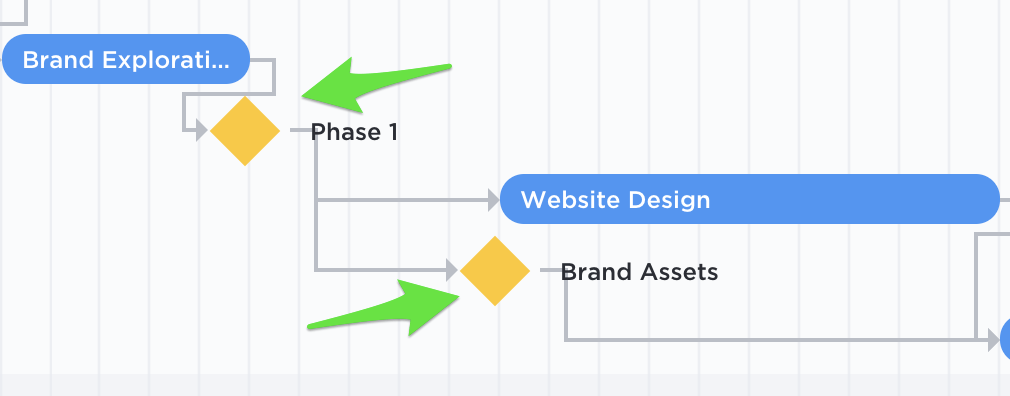
No matter what type of view you have chosen, you will never miss out on the milestone moments in your project. Turn any task into a milestone with the click of a button and filter milestones to check when they were achieved in a calendar year.
For HR teams, ClickUp offers a perfect employee productivity tracking tool. For other management teams, ClickUp is an ideal employee engagement software.
HR teams visualize workflows and arrange resources quickly using the form, table, and workload views.
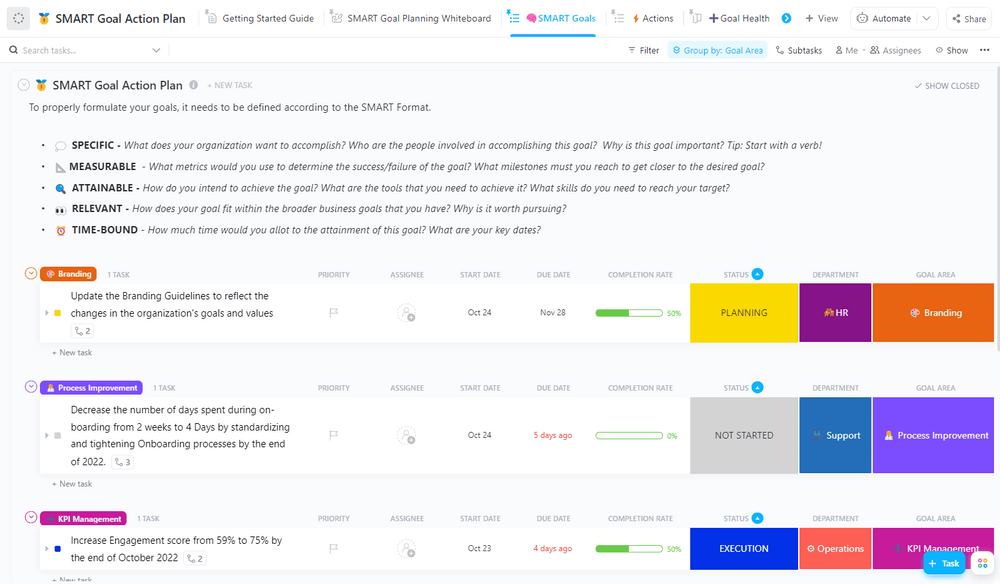
ClickUp’s dashboard gives a holistic view of the milestones and high-level access to the KPIs and targets the team has to achieve. Whatever your HR goal is, the dashboard allows everyone to track the progress and be on the same page.
ClickUp is also a one-stop employee experience platform for management teams to design an employee development plan and employee engagement activities. The management teams execute these plans to keep employees focused and get their maximum contribution.
ClickUp acts as an end-to-end platform that empowers the leadership team to
Going a step further, the HR team customizes the plan by adding custom views, fields, and statuses and breaks down the overarching goals into smaller manageable tasks for different teams.
Although ClickUp is technically not a performance review software, ClickUp’s performance review templates make setting up performance review processes a breeze.
ClickUp Templates is a shortcut to executing things faster with ready-to-use designs. Here are a few examples of ClickUp templates that will be highly useful in planning employee reward programs.
The Annual Goals Template lets you set yearly goals, break them into smaller tasks, and track the progress of each project. Assign tasks, set priorities, and keep everyone accountable for their part. Employees refer to this template to ensure they’re progressing in the right direction.
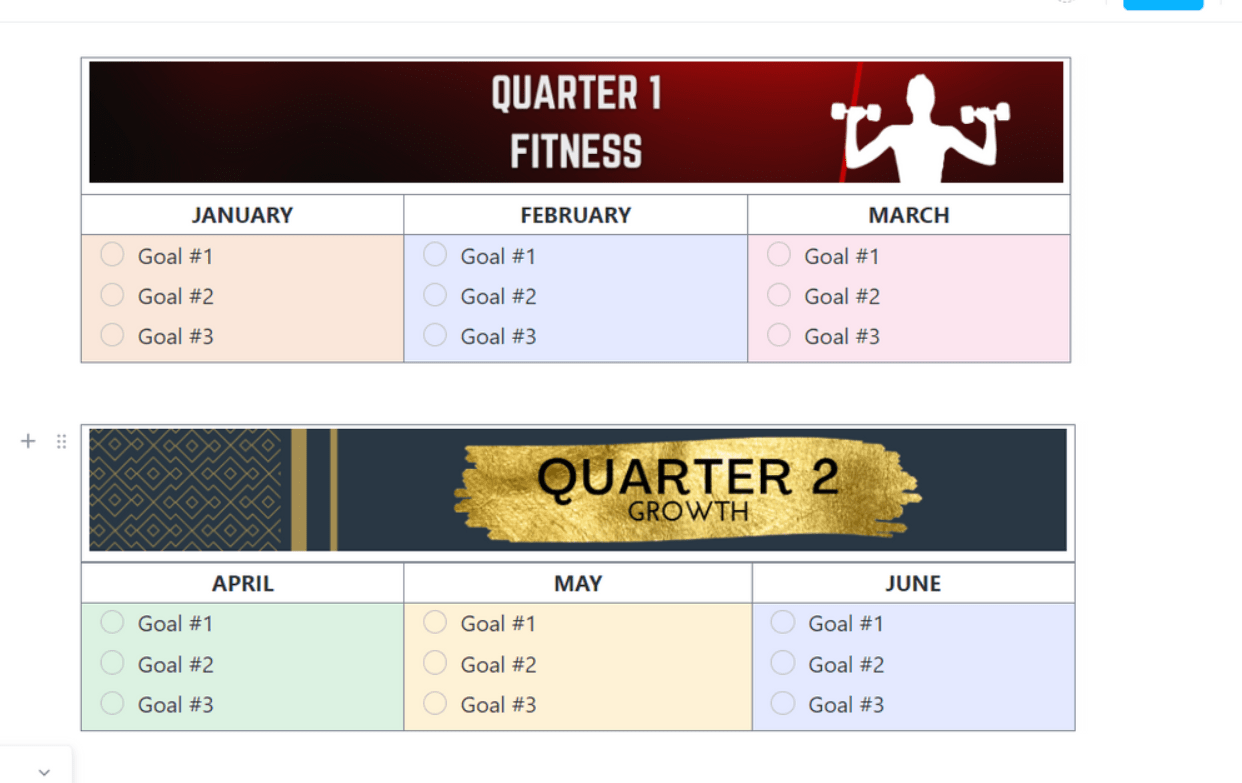
HR teams use the Performance Report Template to track team performance in real-time and analyze trends using visualizations and graphs. The best part is that this template allows monitoring KPIs in real-time and creating automated reports with no extra effort to share with stakeholders.
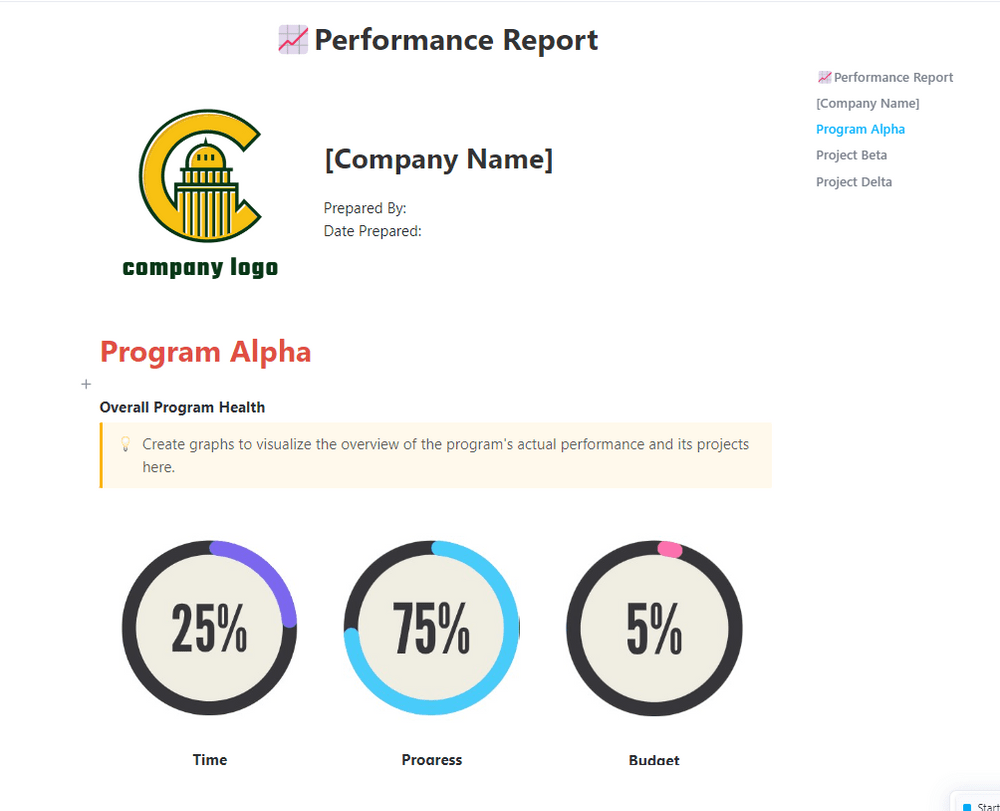
An employee recognition program has several nuts and bolts. ClickUp’s Employee Development Plan Template helps you track your employee’s growth with custom statuses, custom views, and project management through time-tracking capabilities.
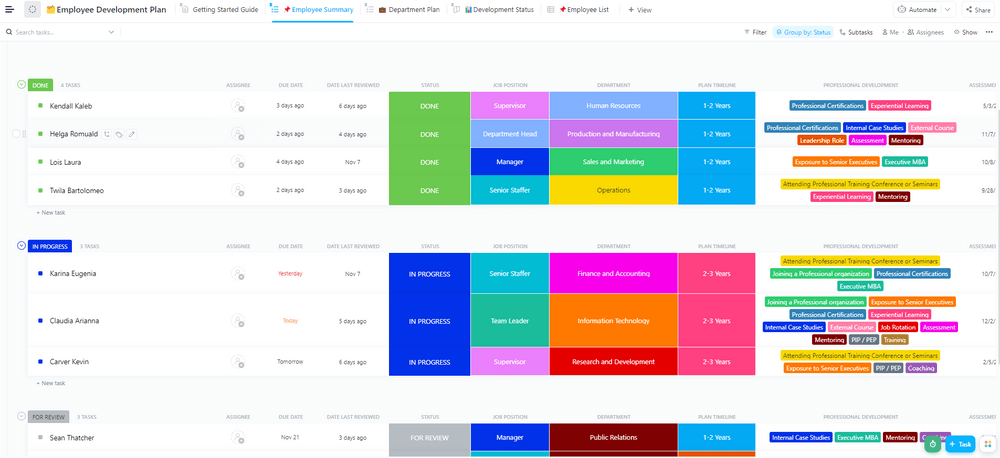
The key to a successful employee engagement and reward program is to incentivize them based on their progress and contribution towards the company goals.
The Milestone Template is an easy way to visualize the milestones in a project. This gives team leaders a quick overview of the critical milestones in a project. The learnings are used to predict the timeline of future projects.

You need all hands on deck to successfully set up and run an employee reward program. HR and management leaders need a beginner-friendly look such as ClickUp to set the ball rolling.
When running an employee rewards and recognition program for the first time to improve employee engagement, ClickUp is the best choice. Even your HR team can set up the basic employee reward system and track the program’s success.

Start with setting up tasks and assign comments as action items. Add guidelines for your reward programs on ClickUp Docs and connect them to your existing workflows. Use the Whiteboard to brainstorm ideas and add notes about your corporate rewards programs.
Stay on track with goals, set clear and measurable timelines, and automate progress tracking for both long-term and short-term goals.
Visualize each employee’s progress in real-time with ClickUp’s fully customizable dashboards and get rich insights at a glance.
ClickUp’s integration with employee monitoring software gives managers real-time information to evaluate employee performance. Save time that would otherwise go into exporting data from different sources into your rewards and recognition programs.
Pre-built performance review templates are a time-saver for the busy HR team. All you need to do is plug-and-play your requirements into the template to get started.
Creating an employee rewards program is easier than ever!
Sign up on ClickUp for free and build your first employee reward system.
© 2025 ClickUp